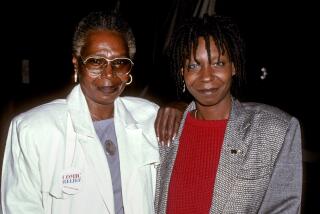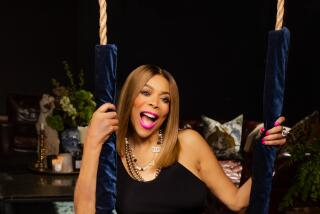Book review: ‘Wendy and the Lost Boys: The Uncommon Life of Wendy Wasserstein’
Wendy and the Lost Boys
The Uncommon Life of Wendy Wasserstein
Julie Salamon
Penguin Press: 461 pp., $29.95
Along with their crackling urban wit, Wendy Wasserstein’s plays are notable for their introspective candor about the plight of certain well-educated baby boomer women — “uncommon women,” to borrow the phrase from her breakthrough drama “Uncommon Women and Others” — trying to reconcile professional ambitions with personal longings. These comedies of ideas, though populated with sensitively drawn female figures, are ultimately less memorable for their protagonists than for their reflections of a rapidly shifting zeitgeist.
But as revealed by Julie Salamon’s top-notch biography of the playwright, “Wendy and the Lost Boys,” Wasserstein did indeed create a larger-than-life character worthy of a modern-day Ibsen — her own. A gregarious New York hobnobber much beloved in the theater community, she seemed to live her life on the public stage, yet she protected her privacy with a fierceness that left those closest to her wondering, after her death from cancer at 55 in 2006, whether they really knew her at all.
Meryl Streep, a classmate at the Yale School of Drama, makes an observation about Wasserstein that only grows in incisiveness the more her private story becomes known: “To me she always seemed lonely, and the gayer her spirits and the more eager her smile, the lonelier she seemed.”
No life is an open book, but Wasserstein took it to another level. Much as she enjoyed mythologizing in print and in person her high-achieving family, whose upward mobility from Brooklyn to Manhattan came courtesy of a textile manufacturing business, she wasn’t as forthcoming about her brother Abner, who had been sent away after an illness left him developmentally disabled. Lola and Morris, Wasserstein’s Polish-Jewish immigrant parents, set the don’t-ask-don’t-tell tone. Their relationship contained a major bombshell (Lola had originally been married to Morris’ brother, who died as a young man) that forced a stunned Wasserstein to redraw her family tree as a young adult.
Blessed and cursed with great material, she was careful about how she mined it for her plays and personal essays. She was compelled to speak about her ostentatiously successful siblings (her sisters, Sandra and Georgette, figure prominently in her hit comedy “The Sisters Rosensweig”), but she was just as compelled to selectively censor what she included. Bruce, her billionaire investment banker brother, didn’t appreciate the way she caricatured their parents in her play “Isn’t It Romantic,” and Wasserstein grew wary of her more stereotypical shtick.
A good thing too: Wasserstein’s weakness for sitcom had to be held in check if she were to artistically progress. Dramatizing her own struggles in the context of her era proved to be an ideal solution, one that led to her most critically acclaimed work, “The Heidi Chronicles.” The family comedy, naturally, continued offstage. After she was told that “Heidi” won the Pulitzer, Wasserstein called her mother with the news only to confront the deflating question, “Is that as good as the Tony?” After her play nabbed that as well, she still felt incomplete, redeemed as a writer but perennially lacking as an unmarried daughter.
Forever in search of a significant other, she had a string of gay “husbands,” most of them theater luminaries, Salamon tells us, including André Bishop, artistic director of Playwrights Horizons and later Lincoln Center Theater (two crucial incubators of Wasserstein’s plays); playwright Christopher Durang; director Gerald Gutierrez; and costume designer William Ivey Long. Wasserstein had a sexual relationship with playwright Terrence McNally, who apparently ended the affair as abruptly as he started it. These men were favored over more viable heterosexual choices, leaving one to speculate that much as Wasserstein was tormented by Lola’s traditional expectations she was just as set upon subverting them.
Wasserstein concealed not just the paternity of her daughter, Lucy Jane, but the very fact of her pregnancy from some of her nearest and dearest. To bear a first child at 48 is risky business (Lucy Jane was born premature, weighing less than 2 pounds), but stage-managing secrets, even when she was broadcasting her experience in the New Yorker, was Wasserstein’s specialty. True to form, she kept her battle with lymphoma tightly under wraps.
Salamon, a former film critic and cultural reporter whose book “The Devil’s Candy” has become a classic exposé of the movie business, brings a wide repertoire of skills to the challenge of exploring a subject whose appearance of openness turned out to be an ideal disguise for furtiveness. A dogged reporter who interviewed nearly 300 people, Salamon maintains a stringent critical perspective that is rare in a biographer granted access to private letters, diaries and the confidences of bereaved family members, loyal assistants and staunch friends.
Like many artists, Wasserstein, though conspicuously bright, was an underachieving student. Nonetheless, she made it into Mount Holyoke and the Yale School of Drama, graduating from both without distinction. (She also earned a creative writing degree from New York’s City College.) Salamon lets us see how enthralled Wasserstein was by Ivy League-Seven Sister prestige and privilege — and just how anxious she could be about her own less-than-stellar standing in this elite realm.
This attitude reflects a psychological pattern Salamon labels “superior-inferior” to indicate the way grandiosity alternated with insecurity in Wasserstein’s personality. But the biography doesn’t overplay its interpretive hand. Salamon delineates questions about Wasserstein’s identity without resorting to schematic answers and maintains an open mind about the varieties of adult intimacy, which for Wasserstein rarely conformed to conventional models.
Still, one can’t help feeling protective of Wasserstein in the face of so much prying. Should anyone who so carefully edited her public presentation have her middling report cards dug up, her lovelorn letters with their multiple misspellings excerpted and her faulty hygiene and slovenly habits ratted out? Biographers, the good ones anyway, are killers. Salamon, in her defense, doesn’t want to destroy our memory of the zaftig Broadway darling with the contagious giggle; she simply wants to offer a more realistic portrait that clarifies the wider cultural context of her artistic achievement.
The book, less a literary reckoning with Wasserstein’s legacy than a frank character study, is superbly paced. Corpulent biographies, in which the subject’s breakfasts are analyzed along with her every Post-it jotting, have become such a vogue that one might hesitate at the 400-plus length of this one. But the work unfolds with an alacrity that had me fearing the end not just because it was such a tartly compelling read but because it’s still so hard to accept a theatrical world without Wasserstein around to make it seem so much more magical.
More to Read
The biggest entertainment stories
Get our big stories about Hollywood, film, television, music, arts, culture and more right in your inbox as soon as they publish.
You may occasionally receive promotional content from the Los Angeles Times.











